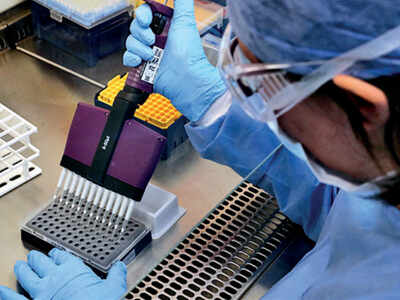
HYDERABAD: Centre for Cellular and Molecular Biology (CCMB) has decoded 400 whole-genome sequences and submitted them to global database of SARS-CoV-2 (coronavirus). Of the 2,000 genome sequences submitted to GISAID database from India, majority are from CCMB. The premier institute has been conducting Covid-19 tests daily on hundreds of samples in Telangana.
“CCMB has done 400 genomes. Many of them are submitted to GISAID. In India, CSIR and other labs have done 2,000 genome sequences of coronavirus,” CCMB director Rakesh Mishra told TOI.
Virulent strain same across the world
GISAID is the primary source of genomic data of influenza viruses at global level. Hyderabad-based Centre for DNA Fingerprinting and Diagnostics has also submitted whole genome sequences to the database.
GISAID database has so far accumulated 75,581 viral genome sequences from across the world. Genetic sequencing is crucial in identifying the host response and population vulnerability to Covid-19. In polio eradication too, genetic sequencing played an essential role.
CCMB scientists found there was no significant genetic variation of the isolates as there were no virus mutants. “Genomic differences are not much. Earlier, we had found differences to the extent of 40%. The weaker strain disappeared, and now the differences are less than 5%. It is the same virulent strain across the world. There is no regionspecific strain,” Dr Rakesh Mishra said.
CCMB scientists have submitted three research papers — two on genome sequencing and one on a new method of Covid-19 testing — to various journals. “All papers are in the process of review,” the CCMB chief said.
He said there was a long roadmap for Covid-19 vaccination. “We are working with several companies. We are providing them with virus culture we made in our lab. A lot of research is going on the vaccine front,” the CCMB scientist added.
“Clinical trials, vaccine production and vaccination will take a long time. It is a big task to immunise the population,” he said, adding “There are studies on why patients are losing taste and why a large number of them are asymptomatic.”
“CCMB has done 400 genomes. Many of them are submitted to GISAID. In India, CSIR and other labs have done 2,000 genome sequences of coronavirus,” CCMB director Rakesh Mishra told TOI.
Virulent strain same across the world
GISAID is the primary source of genomic data of influenza viruses at global level. Hyderabad-based Centre for DNA Fingerprinting and Diagnostics has also submitted whole genome sequences to the database.
GISAID database has so far accumulated 75,581 viral genome sequences from across the world. Genetic sequencing is crucial in identifying the host response and population vulnerability to Covid-19. In polio eradication too, genetic sequencing played an essential role.
CCMB scientists found there was no significant genetic variation of the isolates as there were no virus mutants. “Genomic differences are not much. Earlier, we had found differences to the extent of 40%. The weaker strain disappeared, and now the differences are less than 5%. It is the same virulent strain across the world. There is no regionspecific strain,” Dr Rakesh Mishra said.
CCMB scientists have submitted three research papers — two on genome sequencing and one on a new method of Covid-19 testing — to various journals. “All papers are in the process of review,” the CCMB chief said.
He said there was a long roadmap for Covid-19 vaccination. “We are working with several companies. We are providing them with virus culture we made in our lab. A lot of research is going on the vaccine front,” the CCMB scientist added.
“Clinical trials, vaccine production and vaccination will take a long time. It is a big task to immunise the population,” he said, adding “There are studies on why patients are losing taste and why a large number of them are asymptomatic.”

Coronavirus outbreak
Trending Topics
LATEST VIDEOS
City
 'Wanted to teach Hindus a lesson' using political power, ex-AAP councillor Tahir Hussain confesses
'Wanted to teach Hindus a lesson' using political power, ex-AAP councillor Tahir Hussain confesses  48-hour countdown to Ram Mandir Bhumi Pujan in Ayodhya; invitation cards sent
48-hour countdown to Ram Mandir Bhumi Pujan in Ayodhya; invitation cards sent  UP CM Yogi Adityanath takes stock of preparations in Ayodhya ahead of Ram Temple bhumi pujan ceremony
UP CM Yogi Adityanath takes stock of preparations in Ayodhya ahead of Ram Temple bhumi pujan ceremony  J&K: Army Jawan abducted from Kulgam, vehicle set ablaze; massive search operation launched
J&K: Army Jawan abducted from Kulgam, vehicle set ablaze; massive search operation launched
More from TOI
Navbharat Times
Featured Today in Travel
Get the app





